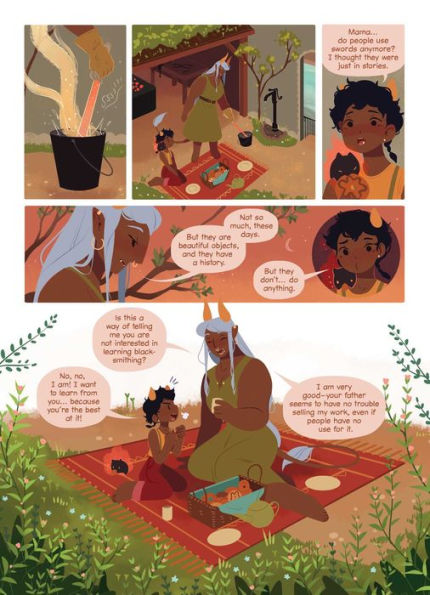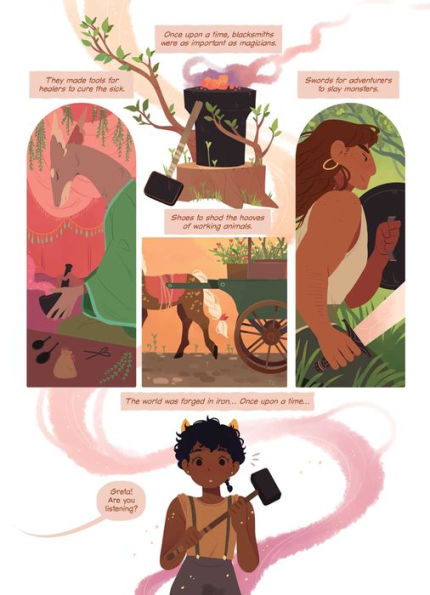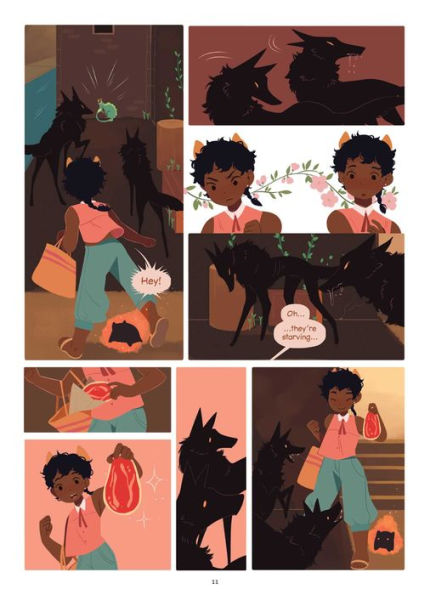09/11/2017
Old crafts are falling by the wayside in the enchanting fantasy world of O’Neill’s second graphic novel, following Princess Princess Ever After. Part goblin, part human, Greta, a girl with brown skin and squat horns, is learning her mother’s trade of blacksmithing, even though swords aren’t used for much anymore. After rescuing a tiny tea dragon that has gotten lost at the market, Greta starts learning how to care for these creatures, whose horns sprout leaves that are harvested for tea. O’Neill sets her story over four chapters, one for each season, gradually expanding Greta’s world and her understanding of it. Colored in a palette of warm greens, pinks, oranges, and blues, her delicately drawn panels hum with a subtle romantic energy, particularly when Greta learns the backstory between the two remaining members of the Tea Dragon Society, a goatlike creature named Hesekiel and his strapping, wheelchair-using partner, Erik. (There’s also a whiff of burgeoning romance between Greta and Minette, a girl with unreliable memories who is also learning to care for the dragons.) A quiet, charming story of nurturing friendships and traditions. Ages 9–12. (Oct.)
SCHOOL LIBRARY JOURNAL -- Gr 4 Up-Greta is a young blacksmith apprentice who wonders whether her mother's craft is still relevant in contemporary society. When she rescues a little lost dragon in the marketplace and returns it to its owners, Greta learns about another fading art form-the care of tea dragons, small creatures who grow tea leaves out of their horns and antlers. She becomes fascinated with the enchanting dragons and their caretakers, and begins to appreciate how traditional crafts can create their own kind of magic by enriching lives, including hers. This book is wonderfully inclusive, and depicts a distinct and expressive cast of LGBTQIA characters and people of color. The title is reminiscent of a younger, more innocent version of Brian K. Vaughan and
Fiona Staples's "Saga," with many of the main characters possessing horns and antlers. The artwork is soft and fluid, with lots of rounded edges and complementary tones. The backgrounds are an integral and memorable part of the story-some details are so lush that they give the appearance of tapestries.
VERDICT This warm and funny story would be a wonderful addition to most graphic novel collections. It quietly illustrates and normalizes a variety of family situations and personal identities.-Kelley Gile, Cheshire Public Library,
CT
SHELF-AWARENESS -- Once upon a time, blacksmiths were as important as magicians. They made tools for healers to cure the sick. Swords for adventurers to battle monsters. Shoes to shod the hooves of working animals. The world was forged in iron, once upon a time. Broad shouldered, horned and boasting many gold piercings, Greta's half-goblin mother is a blacksmith who knows the importance of passing on a trade. As her mother's apprentice, Greta shares her reverence for blacksmithing, but she also has the same gentle and sensitive nature as her bespectacled, merchant father. On her way home from a day working in her mother's shop, Greta finds two large, scary-looking dogs cornering a tiny, terrified animal. Realizing quickly that the only danger is in how hungry the poor dogs are, Greta gives them the meat she was bringing home for dinner
("Mama's gonna be mad about the meat, but that's ok. Nobody deserves to starve.") and then scoops up the frightened little creature. At home, she gets a closer look at the animal. Seafoam green in color, it looks to be some sort of baby dragon... with leaves growing out of its horns. Greta's scholarly father knows exactly what the animal is and who it belongs to. He sends her off to return it. A "little way out of town," Hesekiel runs a tea shop. Tall, slim and vaguely reminiscent of a sophisticated donkey, he is a Sylph who lives with his human partner, Erik. Hesekiel is delighted to have Greta reunite him with
Jasmine and takes special notice of Greta's kind care of the creature and
Jasmine's affinity for the human. Tea Dragons are mercurial, domesticated animals--one moment sweet and cuddly, the next angry and biting--who are particularly distrusting of strangers due to a long history of being targeted by thieves. A Tea Dragon spends its entire life with its owner, nosily picking up matters in the human's life, big or small, and hoarding them. The leaves that grow around their horns can be harvested and turned into highly desired tea, but raising a Tea Dragon (and its leaves) to maturity is a difficult and timely task. Of the many members who used to be part of a worldwide Tea Dragon appreciation and caregiving group called the Tea Dragon Society, Hesekiel and
Erik are now the only two left. Like Greta's mother's blacksmithing, as the pace of life quickens, fewer and fewer people specialize in the more time-consuming trades. In addition to several Tea Dragons, there is also an accidental apprentice in the home of Hesekiel and Erik: a primarily mute young goblin named
Minette who has lost her memory. The only long-term memory she has is of being gifted with "future sight" and thus training to become a prophetess; she continues to have difficulty forming new memories. Because of this, she is nervous and embarrassed around people, preferring the company of the devoted
(though labor-intensive) dragons. Greta's interest in and commitment to the dragons (and to Minette, Hesekiel and Erik) pulls her into the cozy, slow-paced world of the Tea Dragon trade. In time, Minette opens up and grows to befriend
Greta and the two young girls and the older male couple form a brand-new Tea
Dragon Society. After a few seasons of working with the Society, Hesekiel offers
Greta the chance to try some of the tea. Tea Dragons tea has a special property that gives the drinker a sensory experience depicting much of the dragon's owner's life (all those tidbits the nosy dragon hoarded over the years). Shown through the use of wavy lines and rounded, atypically shaped panels, Greta's tea experience shows her the story of Hesekiel and Erik meeting and falling in love.
She also learns through Jasmine's tea leaf recollections why Erik is in a wheelchair. The pace of Katie O'Neill's (Princess Princess Ever After) world is reflected by the design of the graphic novel: all of the colors are gentle and fully saturated, the story development leisurely yet full of life. There are no enormous cliffhangers or heartrending love affairs, but every character, even the dragons, is such a fully realized individual that the reader wants to know more. The page's natural white space acts as the borders for each panel illustration, allowing for individual panels to spread out organically--many panels are rectangular, while some have undulating edges, some overlap other illustrations and some are not panels at all but simply a figure on white space.
The magic of the world is in the forefront as the novel and color palette move from season to season, beginning and ending with spring. Greta's story is soft and sweet, a journey of growing love and friendships. And for readers who want more, "Extracts from the Tea Dragons Handbook" can be found in the back,
explaining more about the creatures with illustrations of dragons (such as
Hibiscus) not seen in the graphic novel. --Siân Gaetano
PUBLISHERS WEEKLY -- Old crafts are falling by the wayside in the enchanting fantasy world of O'Neill's second graphic novel, following Princess
Princess Ever After. Part goblin, part human, Greta, a girl with brown skin and squat horns, is learning her mother's trade of blacksmithing, even though swords aren't used for much anymore. After rescuing a tiny tea dragon that has gotten lost at the market, Greta starts learning how to care for these creatures, whose horns sprout leaves that are harvested for tea. O'Neill sets her story over four chapters, one for each season, gradually expanding Greta's world and her understanding of it. Colored in a palette of warm greens, pinks, oranges, and blues, her delicately drawn panels hum with a subtle romantic energy,
particularly when Greta learns the backstory between the two remaining members of the Tea Dragon Society, a goatlike creature named Hesekiel and his strapping,
wheelchair-using partner, Erik. (There's also a whiff of burgeoning romance between Greta and Minette, a girl with unreliable memories who is also learning to care for the dragons.) A quiet, charming story of nurturing friendships and traditions.
KIRKUS -- In this tale based on the imaginative webcomic, a young blacksmith finds herself welcomed into a society that cares for tea-leaf-producing minidragons.With perky black pigtails, pink horns, and brown skin, Greta is training to be a blacksmith like her mother (who has large pink horns, brown skin, a nose ring, and impressive musculature). In their world,
blacksmithing is dwindling in importance, although Greta's mom strives to preserve the art. One day, Greta happens across a darling, small green dragon.
She learns the dragon belongs to a dignified-looking bespectacled llamalike creature named Hesekiel. Hesekiel, his wheelchair-using partner, Erik, and the enigmatic, hooved-and-antlered, cotton-candy-tressed Minette make up what is left of the Tea Dragon Society, a group that forms close bonds with the dragons and harvests the tea leaves the creatures grow. The relationship between dragon and owner, much like tea harvesting, is one that requires patience and an appreciation for craftsmanship; that general feeling is apparent as O'Neill's gentle offering languidly unfurls without much dramatic tension. As she did in
Princess Princess Ever After (2016), O'Neill has composed a feel-good tale just right for middle-grade fantasy fans. In alluringly hued, manga-inspired illustrations, O'Neill's diverse characters distray an array of different skin colors, orientations, and abilities. Helping to add depth to the worldbuilding is an excerpt from a fictional tome that explains the history of tea dragons and their individual characteristics.Undeniably whimsical and extremely cute.
(Graphic fantasy. 7-11)
2017-07-17
In this tale based on the imaginative webcomic, a young blacksmith finds herself welcomed into a society that cares for tea-leaf-producing minidragons.With perky black pigtails, pink horns, and brown skin, Greta is training to be a blacksmith like her mother (who has large pink horns, brown skin, a nose ring, and impressive musculature). In their world, blacksmithing is dwindling in importance, although Greta's mom strives to preserve the art. One day, Greta happens across a darling, small green dragon. She learns the dragon belongs to a dignified-looking bespectacled llamalike creature named Hesekiel. Hesekiel, his wheelchair-using partner, Erik, and the enigmatic, hooved-and-antlered, cotton-candy-tressed Minette make up what is left of the Tea Dragon Society, a group that forms close bonds with the dragons and harvests the tea leaves the creatures grow. The relationship between dragon and owner, much like tea harvesting, is one that requires patience and an appreciation for craftsmanship; that general feeling is apparent as O'Neill's gentle offering languidly unfurls without much dramatic tension. As she did in Princess Princess Ever After (2016), O'Neill has composed a feel-good tale just right for middle-grade fantasy fans. In alluringly hued, manga-inspired illustrations, O'Neill's diverse characters distray an array of different skin colors, orientations, and abilities. Helping to add depth to the worldbuilding is an excerpt from a fictional tome that explains the history of tea dragons and their individual characteristics. Undeniably whimsical and extremely cute. (Graphic fantasy. 7-11)













